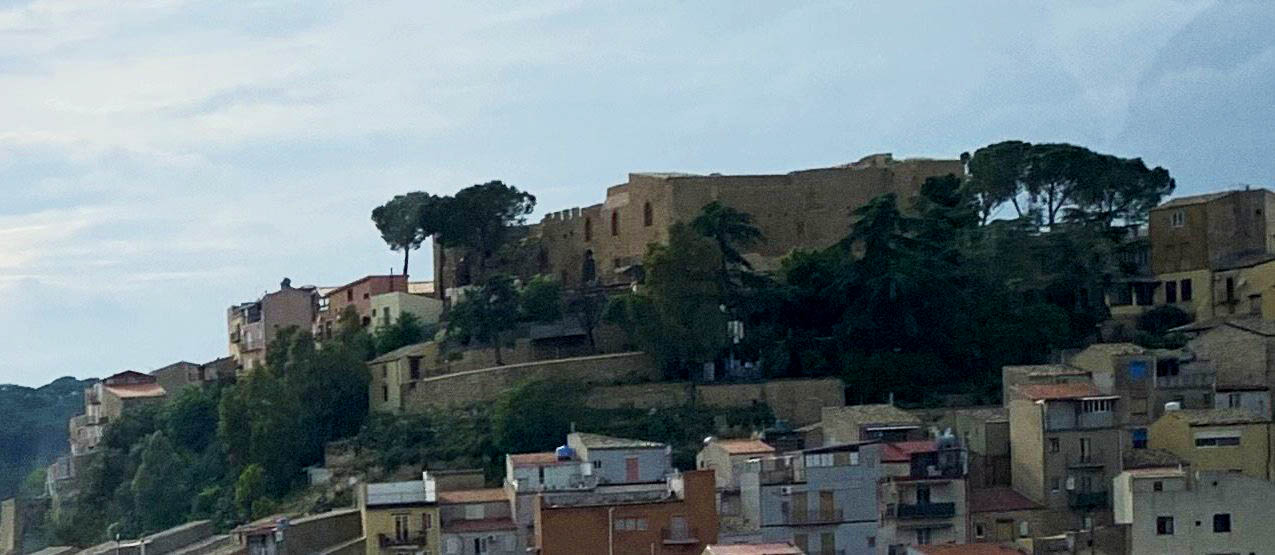Ho
Piazza Armerina
The early town of Piazza had many names from 1090 - viz. Platia oppidum, Jozo de Plaza and Miles Castri
to name a few, although Edrisi in 1154 mentions no castle here.
Between 1122 and 1148 the town was certainly occupied, there seeming to
be both an old town (Piazza Vecchia) of the Muslims and a new town (Nuova Piazza)
of the Normans. This seems to have led to the erroneous
conclusion that 2 towns must have meant 2 different sites, rather then
districts within the same settlement. Consequently castles are
(probably wrongly) postulated at Piazza Vecchia and Piano Marino.
In 1161 Tancred of Lecce (d.1194) and Roger Sclavo stirred up a
revolt amongst the Lombards in Piazza Armerina and Butera against King William (d.1166).
This
is thought to have led to the destruction of Villa del Casale, the
third century AD Roman villa. During this destruction the royal
army fragmented and the Christians attacked the Muslims and would not
desist from this despite the protestations of the king.
Before 1250 Galvano Lancia (d.1268) claimed the county of Butera through the inheritance of his mother, who would appear to have been Bianca Maletta (d.1215+). After Frederick II's death in 1250, Peter Ruffo of Messina (d.1256+), acting as virtual ruler of Sicily and owing allegiance to the pope refused the order of Prince Manfred (d.1266) to turn Butera
and the other castles including Piazza Armerina over to him. In
1254 the place rebelled against Ruffo. The townsmen later killed
his emissary which led to a battle at the town in which Peter was
defeated. Then, after his defeat at Piazza Armerina, Peter
marched back through Agira on his way to Messina. Soon afterwards he was expelled from Sicily, but the Sicilians, under the influence of Messina, refused to accept the regent, Manfred. In 1256 a civil war began with Palermo supporting the regent. Consequently in the summer of 1257, after the surrender of Messina, only Aidone, Piazza Armerina and Enna
continued in their resistance. Frederick Lancia, the royalist
Marshall of Sicily and brother of Galvano, then marched on the
rebels. He found Piazza defended zealously, but still managed to
storm the city killing many, but allegedly losing no men himself.
It is to be presumed that the place was then passed to Galvano
Lancia. Subsequently it must have passed to King Charles after
his victory over King Manfred in 1266. There is no mention of a
castle at this time.
The current castle is not
thought to have been built until the reign of King Martin I
(1392-1409) - from which it is claimed to be known as The Aragonese
Castle. This inference seems built upon the singular reference to
Prior Giovanni Suriano of St
Andrew, a former knight of the Holy Sepulchre, having been castellan
here in 1396. Obviously this shows nothing more than there was a
castle at Piazza Armerina in 1396.
The fortress of Piazza Armerina still existed in
1421 when Alfonso the Magnificent (il Magnanimo)
gave his brother, Peter, Piazza castle. After Peter's death,
Alfonso granted the fortress to Alfonso Cardines. The castle then
remained in that family's hands until 1812 when the castellans of all
the
royal castles were dismissed. The fortress was then used as a
prison, although in 1876 the Palermo Court of Appeal recognised the
heirs of the Cardines as legal owners of the castle.
Description
The castle has 4 boldly projecting rectangular towers at the corners,
the northwest one of which lies on a slightly different alignment to
the
others. The southwest tower has single first floor loops facing
west and north. That to the south has been replaced by a
rectangular window. The 2 look like early crossbow loops,
perhaps dating back to the time of the 1161 revolt if the castle is
really that old.
The fortress is surrounded by an outer ward which mimics the layout of
the inner. The walls of this are built at an angle and look
like sixteenth century artillery works, although they are probably
earlier and cannot support artillery. Internally there are
many ruinous buildings, but entrance only appears to have been gained
from the south via a clearly inserted gateway. This side has
the bulk of the castle windows, which again are clearly
inserts. The whole structure is rubble built and although there are other castles with rectangular corner towers, viz Castelbuono, there is no clear parallel to this castle.
Why not join me here and at other Sicilian
castles? Information on this and other tours can be found at Scholarly
Sojourns.
Copyright©2019
Paul Martin Remfry

